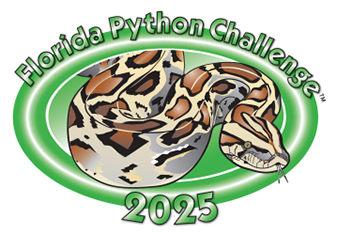Humane Methods for Killing Pythons
Burmese pythons are not protected in Florida except by anti-cruelty law. There is an ethical and legal obligation to ensure a Burmese python is killed in a humane manner.
Florida Python Challenge™ participants are required by competition rules to follow American Veterinary Medical Association (AVMA) recommendations for a two-step process to humanely kill reptiles, meant to prevent suffering and destroy the brain.
You will be disqualified from the competition if you are found to have inhumanely killed a python.
All participants must read the Rules and take the Required Online Training before they can Register for the event.
Two-step method for humane killing
Many tools are available and legal to use to humanely kill pythons during the event. Regardless of the tools you choose, you must ensure both steps are completed to humanely kill the python:
Step 1: The application of the tool should immediately result in the python losing consciousness.
Step 2: Immediately and substantially destroy the python’s brain by manually “pithing” which prevents the python from regaining consciousness.
For more information visit the 2020 AVMA Guidelines for the Euthanasia of Animals.
Step 1: Immediate loss of consciousness

Target the Brain:
- Draw an imaginary line between each eye and opposite jawbone.
- The brain is located where the two lines intersect.
- Apply the tool to the target area (brain) to achieve an immediate loss of consciousness.
Tools for Step 1: Immediate loss of consciousness
Captive bolt stunners
Air guns
During the event, the use of firearms is prohibited in all competition locations.
Air guns and captive bolts may be used to humanely kill pythons at any time of day or night. Air guns may not be used for the take of any native wildlife at night.
Manual tools require a human application of force, compared to mechanical tools which are powered by cartridges, compressed air or other mechanisms.
Handheld hammers
Sharp hunting knife, used only in decapitation
Decapitation is allowed in the event only as part of a 3-step method recommended by the AVMA:
- A loss of consciousness;
- Followed by decapitation with a sharp knife;
- Followed by pithing.
Knives are not recommended as a tool to stun or pith a python.
Consider the following points when choosing a tool to complete Step 1: An immediate loss of consciousness:
- Will the tool apply the appropriate amount of force to the python brain to achieve an immediate and total loss of consciousness?
- The AVMA recommends mechanical tools with controlled, consistent and appropriate applications of force when compared to manual tools.
- Per the AVMA, the combined gun and ammunition selected must achieve a muzzle energy of 300 foot-pounds (FPE) to humanely kill animals weighing up to 400lbs. You are responsible for determining if your gun has the appropriate amount force to achieve Step 1.
- Is the tool legal to use in the area?
- Firearms are prohibited during the event in all locations. Air guns and captive bolts may be used to humanely kill pythons at any time of day or night. Air guns may not be used for the take of any native wildlife at night.
- Please review the target area and check that the tool is correctly placed over the brain and safe to apply for you and those around you.
- Be certain you have the required experience and skill to apply the chosen tool correctly to achieve Step 1.
- Important: All tools must be followed by pithing to destroy the brain.
- Knives are not recommended as a tool to stun or pith a python.
Step 2: Destroy the brain

Pithing is an additional technique meant to cause death by increasing substantial destruction of the brain and brainstem. The goal of pithing is to render the cerebral cortex and brain stem nonfunctional.
Regardless of the tool you chose for Step 1, you must immediately complete the following process of pithing to substantially destroy the brain and humanely kill the python:
- Insert a small rod (a rigid, metal tool like a screwdriver, spike or pick of sufficient length) into the cranial cavity.
- Use deliberate, multi-directional movement, move the rod forward along the left and right sides of the brain and then toward the brainstem, ensuring substantial destruction of the brain.
For more information visit the 2020 AVMA Guidelines for the Euthanasia of Animals.
